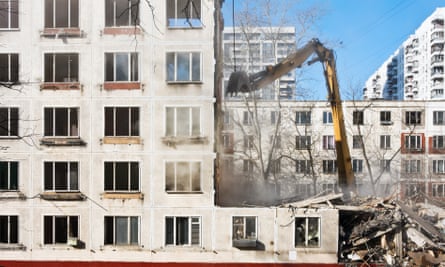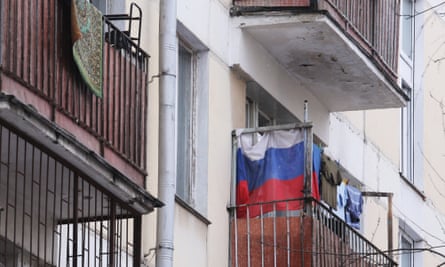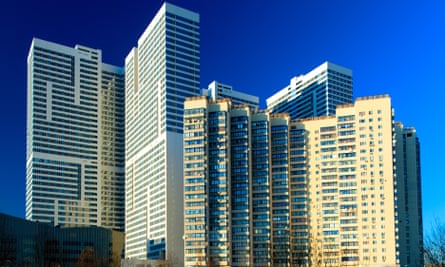In the 1970s, machinist Yevgeny Rudakov was living in a communal apartment with 30 people in north-central Moscow where “there was always a line for the toilet”. He was also in line for his own flat, through the institute where he worked.
Finally his turn came, and he and his wife were given a two-room flat at 16 Grimau Street. Built in 1957, the four-storey, 64-flat building is considered the first “Khrushchevka”, a kind of prefabricated, low-rise flat block that was erected in the tens of thousands across the USSR and came to be called after then-Soviet leader Nikita Khrushchev (The colloquial term has come to apply to almost any late Soviet five-storey residential building.)
Now 16 Grimau Street, along with up to 7,900 other Soviet flat blocks in Moscow, are to be torn down, in what will be one of the largest urban resettlement programmes in history. With the backing of the president, Vladimir Putin, Moscow mayor Sergei Sobyanin has declared the programme an “absolute necessity” to replace ageing housing. He promised the replacement flats would be 20% larger on average.
To Rudakov, however, it is just another example of profit taking precedent over heritage. “This is the first housing block that Khrushchev built. They don’t have any regard for this now,” he said of his home. “Money comes before anything else.” He added that he didn’t “know why Putin said” to tear such flat blocks down. “The building is good, the walls are thick.”

Many residents have joined him in speaking out, fearful that the government will build huge housing towers rather than comfortable neighbourhoods, and resettle people far away from their current addresses. Many of the Khrushchevka buildings could be renovated, they say. Analysts have argued the demolition project is driven by politics and profits.
Furthermore, the federal legislation to give the Moscow city government power to knock down entire neighbourhoods has worrying implications for the rights of residents and small-business owners. Residents who do not sign an agreement to transfer ownership of their flat within two months will be taken to court. “They are forcing people out, like under Stalin,” said activist Lena Bogushch.
Opposition activist and former MP Dmitry Gudkov noted that the legislation would allow the government to tear down not just Soviet prefabricated flat blocks, but also nearby “analogous” buildings. When asked about how the fate of nearby buildings would be decided, the author of the law, MP Mikhail Degtyaryov, recently told TV Rain that a city commission would simply “take a neighbourhood and circle” the whole thing for demolition.
“The law allows the programme to be realised not in the interests of residents, but in the interests of the construction lobby,” Gudkov said.

Since Sobyanin came to power in 2010, Moscow has tackled several huge urban development projects. It has refurbished Gorky Park, opened the Moscow Ring Railroad, and started a 120bn-rouble (£1.4bn) renovation of one million sq metres of streets. It has encouraged the demolition and redevelopment of gigantic Soviet industrial areas.
But the programme to renovate five-storey buildings, as the city euphemistically calls it, will be by far the largest undertaking yet. Although the city has yet to list the buildings that will be demolished, Sobyanin has promised that 25 million sq metres of residential real estate – more than 10% of the city’s housing stock – will be torn down. An estimated 1.6 million people will be resettled. The city says it will spend at least 300bn roubles, and independent experts have estimated the actual investment will be 3tn roubles.
It’s not clear what kind of buildings will replace the Soviet housing. Moscow’s chief architect declined to comment, and the mayor’s office asked for written questions but failed to answer them.
Ubiquitous throughout the former USSR, Khrushchevka buildings stand as testaments to a sea-change in Soviet policy and culture. Under Joseph Stalin, “Stalinist empire” architecture glorified the USSR with grandiose forms, and most new housing projects were individually designed, ornamental, spacious brick buildings reserved for the Soviet elite. The majority of the population lived in rickety barracks and crowded communal flats, sharing toilets and kitchens and bathing in public steam baths. After Khrushchev came to power, he declared that the architecture of the past 20 years had been full of expensive excesses that were “causing significant harm to the economy and hindering the improvement of residential and cultural and social conditions for the working classes”. Instead, the state should develop unembellished, prefabricated housing that could be erected cheaply and quickly, with the goal of giving every family its own flat.

Thus began a three-decade housing drive that was unprecedented in human history. It ushered in a new, industrial approach to construction: several different designs for prefabricated flat blocks were tried out in the Cheryomushki neighbourhood, where Rudakov lives, as was a residential district layout – minimising through-traffic and maximising green space – that would be repeated throughout the country.
Working mostly with concrete panels and other factory-produced components, brigades of labourers competed to see who could put together the huge flat blocks the fastest. One team managed it in 11 days. According to the Russian state statistics service, the amount of housing built by the state jumped from 26.9 million sq metres during the second five-year plan (1933-37), to 152.2 million sq metres in 1956-60 and 227.6 million sq metres in 1966-1970. Between 1955 and 1964, a quarter of the Soviet population, or 54 million people, received their own flats. By 1975, the state had built 1.3bn sq metres of housing, and it continued to build in huge amounts up until the Soviet breakup.
For the first time, large numbers of people had private housing in the city. This huge resettlement marked a boost in quality of life, a change in living habits, and a cultural shift that was commemorated in works including Dmitry Shostakovich’s operetta Cheryomushki, named after the neighbourhood where the first Khrushchev flats were built. “Look the hallway is ours, look the coat rack is ours! The whole flat is ours, ours! The kitchen too is ours, ours!” sang the main characters in a 1962 film based on the operetta.
According to Olga Kazakova, an art history PhD student and director of the Institute of Modernism, one theory is that along with Khrushchev’s de-Stalinisation policies, the privacy allowed by Khrushchevka flats contributed to the rise of dissident activity, such as samizdat (the copying and passing of banned literature by hand), in the 1960s.
In addition, the new housing was fairly low-density, and its common areas and green space facilitated socialising among neighbours, according to Nikolai Yerofeyev, a philosophy student at Oxford who is writing his dissertation on postwar Soviet housing. He also owns a flat in a Khrushchevka that will probably be torn down.

Of course, such mass-produced housing had drawbacks. The height of functionalism, Khrushchevka were architecturally monotonous: rectangular, five-storey boxes with evenly spaced windows, balconies and staircases. The ceilings were low and single-room flats were typically only 30-33 sq metres, while two rooms were 33-45 sq metres. Lifts and trash chutes were shunned as a costly extravagance. There were complaints about sound isolation and heating in the wintertime. Some included strange innovations, such as a small niche beneath the kitchen window, separated from the outside by only a few centimetres, meant to function as a refrigerator in the cold months.
The five-storey buildings were designed to last about 25 years. Most have served longer, with mixed results. Retired dentist Sofa Shkolnik, who lives with her husband, Felix, in a five-storey flat block built in 1962, said she is warm in the winter and can barely hear the neighbours. The building, which is surrounded by green space with apple, cherry and pear trees and several playgrounds, is on a tentative list of blocks to be torn down. Shkolnik fears they will be resettled to a high-rise building or moved far away from their daughter, granddaughter and great granddaughter, who all live nearby (the city has promised to resettle residents within their districts, but some of these cover large, incongruous areas).
“I love modest housing – a small building, close to the earth, so I can look out the window and see trees and people,” she said, sipping tea on a stool at the tiny kitchen table, a pot of borscht on the stove next to her. Since the water pipes were recently replaced, she added, their building “could serve for a while more”.

But Felix said the sewage drainage system had not been replaced and had burst a pipe twice in the past decade. “We’re on a state of alert in case it breaks in another place, because the utilities are old,” he said, adding that he had recently drilled into the concrete panel wall to find it was disintegrating.
Sobyanin argued that the five-storey buildings are too difficult to renovate, since the pipes for plumbing and central steam heating are built into the wall. “Even if we do some sort of renovations in these buildings, in 10 to 20 years they will nonetheless turn into hazardous housing,” he told Komsomolskaya Pravda newspaper.
The quality and condition of five-storey buildings varies widely. While many were built with concrete, others were built with bricks, which are typically sturdier and more heat-efficient. The most dilapidated Khrushchevka buildings in Moscow have already been torn down, according to Yerofeyev. He called the programme an attack on “low population density, [which] apparently is too big a luxury in Moscow now”.
“The argument that they are in bad condition structurally is not convincing, especially since there are massive projects to reconstruct Khrushchyovka buildings in eastern Europe,” he said. “There are many methods of how to deal with (ageing prefabricated housing), and of course tearing it down and building a new tower is not the best one.”

In one notable example, Stefan Forster architects in Leinefelde, Germany, knocked down the top floors of eight Soviet flat blocks from the 1970s, stripped them down to their concrete structure and outfitted them with new windows and balconies and ground-floor gardens as part of an urban regeneration project.
Forster said renovation costs depend largely on how much is rebuilt to modern construction standards, such as better sound isolation requirements. “In principle, prefab flat blocks are suitable for conversion to affordable housing,” he said.
But Moscow is reportedly not up to the difficulty and cost of such a task. Earlier this month, the respected business newspaper Vedomosti quoted an unnamed official as saying the city had decided that building new housing would be cheaper than renovating. According to official statistics, half of the residential buildings in Moscow are in need of major structural repairs, and only a few dozen have been redone.

Photograph: Alamy
Another reason may be political, as Sobyanin and Putin are both likely to run for reelection in 2018. Political analyst Dmitry Orlov estimated that as long as residents aren’t moved too far away and small business owners are fairly compensated, the new programme could boost electoral support in Moscow by 15% for the mayor and 7% for the president. He based this on how a smaller resettlement programme under previous mayor Yury Luzhkov had “changed public opinion (and) allowed him to preserve a high level of trust over the years”, he said.Activists’ main complaint is that the programme is mostly about money, and both developers and the city stand to make a handy profit. They point to a recent example of a partially completed programme started in 1999 to replace 1,722 five-storey buildings. For that scheme, the city contracted private developers, who built new tower blocks, set aside 30% of the apartments to resettle residents of the old buildings, and sold the rest. Vedomosti quoted a source in the mayor’s office as saying the new programme will free up a large number of land plots that will be sold to investors at auction.
The devil will be in the detail, and specifically in what kind of housing is built and where; new residential towers in Moscow are often as tall as 25 storeys, leading to less personable neighbourhoods and more traffic congestion. Already, Moscow traffic jams are among the worst in the world. Housing density will almost certainly increase, given that that five-storey buildings now occupy 8,000-10,000 sq metres per hectare, while city norms allow for up to 25,000 sq metres per hectare.
“They haven’t told us what technologies will be used in the new buildings, how they will look, and the quality of modern construction in Russia is not that high,” Kazakova said.
According to Maxim Trudolyubov, editor-at-large of Vedomosti, the programme’s results will depend largely on whether private firms or a state construction company build the new housing. “Private companies will need to sharply increase the amount of square metres that exist in Moscow, “which will choke the city for good with torrents of people and transport,” he wrote in a recent column.
For now, residents face an uncertain future. “Where will they put the people?” asked the Shkolniks’ daughter, Anna. “That makes us uneasy.”
Follow Guardian Cities on Twitter and Facebook to join the discussion, and explore our archive here

Comments (…)
Sign in or create your Guardian account to join the discussion